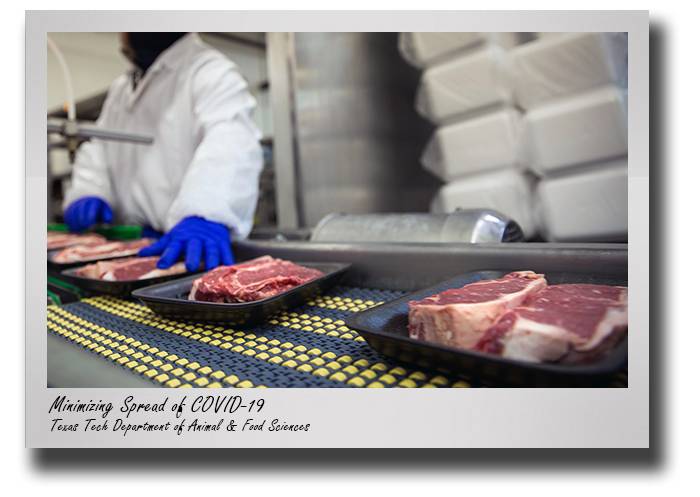AFS’s Leslie Thompson details food safety in the time of COVID-19
By: George Watson
 By now, the vast majority of people worldwide know about the most common means of
transmission for COVID-19. That is why local and state governments around the globe
have instituted preventative measures such as social distancing, shelter-in-place
and stay-at-home orders, and closed non-essential businesses.
By now, the vast majority of people worldwide know about the most common means of
transmission for COVID-19. That is why local and state governments around the globe
have instituted preventative measures such as social distancing, shelter-in-place
and stay-at-home orders, and closed non-essential businesses.
But not all businesses are shut down. In fact, those that deal with food, whether they are grocery stores or restaurants, are still open in some fashion. Therefore, it is vital that the general population practices safe, effective hygiene in order to mitigate the spread of the coronavirus.
 While the most common transmission of the virus is through direct, person-to-person
contact, many have wondered about other methods of transmission. One of those questions
centers around food handling.
While the most common transmission of the virus is through direct, person-to-person
contact, many have wondered about other methods of transmission. One of those questions
centers around food handling.
Leslie Thompson, a professor of food science and graduate coordinator in the Department of Animal and Food Sciences at Texas Tech University, answers those questions while providing handy tips to aid in minimizing the spread of COVID-19.
What are the overall concerns with the coronavirus pandemic when it comes to food safety?
The Centers for Disease Control and Prevention, the Food and Drug Administration and the World Health Organization all emphasize that, according to current knowledge about coronaviruses, they are primarily spread through person-to-person contact by respiratory or saliva droplets, or nasal discharge from an infected person, which is why social distancing and hand washing are so important to prevent the spread of the virus. Regarding coronavirus and foods, there hasn't been a documented case of COVID-19 transmission through foods or food packaging materials.
What specific threats exist when it comes to food safety and the coronavirus? Is it simply contact, like with everything else?
The treatment of the COVID-19 threat related to food safety is minimal based on current knowledge about these types of viruses. It doesn't appear to be transmissible through ingestion of foods, the handling of foods or food packaging materials.
Does the pandemic pose any threat to food supply at this point? Could there be shortages?
The FDA indicates there are no nationwide food shortages. Inventories in certain areas might be low as grocers work to restock and sanitize stores. The U.S. food manufacturing industry is widely distributed across the U.S., and no widespread supply disruptions have been reported in the supply chain. The FDA, other regulatory agencies and states are actively monitoring the food supply chain to identify and respond to potential supply problems.
Additionally, companies and employees that work in the food and agriculture sector are considered Essential Critical Infrastructure Workforce. This designation allows these companies and their employees to continue to work, regardless of national or community restrictions and closures.
What kind of additional steps should consumers be taking when handling food now?
Consumers should follow the same safe food-handling and hygiene practices that have long been recommended by the FDA and U. S. Department of Agriculture. The four key steps are:
• Clean – Keep food contact surfaces clean and sanitized; use a kitchen sanitizer
on counters, sinks, inside refrigerators and other surfaces that can potentially come
in contact with foods;
• Separate – Keep raw meats, poultry, fish and eggs well separated from ready-to-eat
food items and those foods that are consumed raw, like fruits and vegetables;
• Cook – Be sure to cook foods to their required endpoint cooking temperatures and
times. For example, poultry should be cooked to at least 165°F, ground beef to 157°F,
and it needs to stay at that temperature for at least 17 seconds. Cooking destroys
harmful foodborne microorganisms;
• Chill – Raw and cooked meats, poultry, fish and eggs should not remain at room temperature
for long. Also, leftover cooked plant foods (vegetables, rice, beans, etc.) need to be promptly refrigerated if not consumed.
I'm going to add a couple of other recommendations: Wash your hands frequently, especially after handling raw foods and before handling cooked and ready-to-eat foods. A good rule of thumb is to discard refrigerated home-prepared foods after seven days if they aren't consumed in that time frame. These guidelines address the CDC's top five causes of food borne illness.
If consumers are concerned about food or packaging from recent grocery purchases, wash hands well after handling food and food packages when you return from the grocery store and after you remove a food from its original packaging. Also, avoid touching your face when handling foods and packing. In general, these types of viruses have marginal or poor survivability on surfaces, like packing materials especially, those that are coming from a manufacturer that have an extended shipping period or are refrigerated and frozen.
How much can current practices in place at food processing facilities help prevent the spread of the coronavirus?
The current Good Manufacturing Practices and Good Agricultural Practices already in place should address potential coronavirus spread. Since spread of the virus is a personal hygiene issue, practices already in place, such as frequent handwashing, use of disposable gloves, protective clothing, hair and beard nets, use of masks, etc., work well. The FDA has recommended that some food facilities might want to consider cleaning and sanitizing equipment and surfaces more frequently just as an added safety precaution, especially for areas that are "high touch" surfaces. The increased sanitation of "high touch" surfaces will be important in protecting workers and preventing illness by COVID-19 in plant employees.
Could we potentially see food processing facilities shut down in the wake of this pandemic or is their need too important?
Unless a processing facility has a lack of employees due to high number of workers that are sick, it is unlikely a processing facility would be shuttered. If this occurred, it would likely only be a localized occurrence. Additionally, companies and employees who work in the food and agriculture sector are considered Essential Critical Infrastructure Workforce. This designation allows these companies and their employees to continue to work, regardless of national or community restrictions and closures such as shelter-in-place orders.
 Could the biggest threat for consumers be in the purchasing process with people in
the stores not practicing social distancing?
Could the biggest threat for consumers be in the purchasing process with people in
the stores not practicing social distancing?
As long as consumers and retail workers maintain the 6-feet social distancing guidelines;
consumers don't touch their face, eyes or mouth while shopping; use hand disinfectants
when entering and leaving stores; wear a face covering or mask, and wash their hands
well with soap for at least 20 seconds when they get home, the threat should be controlled.
It is also critical that if a consumer or worker has the symptoms of coronavirus they
should not leave home, they need to self-isolate. It's also recommended that only
one designated person do the shopping for a family to minimize potential exposure. Many stores are also implementing additional safety measures such as sanitizing carts
after each use, limiting the number of customers in a store, making aisle traffic
one-way, sanitizing checkout work surfaces frequently, installing Plexiglas shields
to limit staff-customer contact and where possible entering one door and departing
through another.
Many stores are also implementing additional safety measures such as sanitizing carts
after each use, limiting the number of customers in a store, making aisle traffic
one-way, sanitizing checkout work surfaces frequently, installing Plexiglas shields
to limit staff-customer contact and where possible entering one door and departing
through another.
Some additional tips:
- If you touch a food item, take it. Don't put it back for someone else to touch.
- If you use reusable grocery bags, wash them when you get home.
- Go to the store at times when the customer traffic is likely lower.
- If you are concerned about packaging materials wipe them down with a sanitizing wipe and let them dry before storing. Be sure to sanitize the counter with a wipe or kitchen sanitizer when you are done.
- For produce, the FDA recommends washing produce with water slightly warmer than the produce before you use it. If you wash it prior to storage be sure it is dry before placing under refrigeration.
How safe are the curbside pickup and delivery practices being employed by restaurants?
As long as restaurants and grocery stores engaged in curbside and delivery practices follow the guidelines recommended by the CDC and local health departments, the practices should be safe. Again, exclusion of infected workers, social distancing, wearing a face covering, and frequent hand washing with soap for at least 20 seconds are keys for control.
Is there potential for other foodborne pathogens, such as Salmonella or E. coli, to increase with the focus being so much on COVID-19?
It is unlikely that the U.S. will see a spike in foodborne illness as a result of COVID-19. Food producers at the farm level of the food system are required to follow Good Agricultural Practices which address worker and equipment hygiene and safe food production practices. Food manufacturers are required to follow Good Manufacturing Practices, which also address worker and facility hygiene and safe food-processing practices.
These regulations are still in place and facilities are still operating under inspection as appropriate for the type of product and process. Retail facilities are still operating under local (city, county, state) regulations and inspection. If anything, it is possible we could see a decline in foodborne pathogens. The CDC indicates one of the top five causes of food borne illness is poor personal hygiene. In response to the coronavirus the recommended hygiene practices can also help control foodborne illness.
CONTACT: Leslie Thompson, Professor of Food Science and Graduate Coordinator, Department of Animal and Food Sciences, Texas Tech University at (806) 834-8715 or leslie.thompson@ttu.edu
0408NM20
Davis College NewsCenter
-
Address
P.O. Box 42123, Lubbock, Texas 79409-2123, Dean's Office Location:Goddard Building, Room 108 -
Phone
(806)742-2808 -
Email
kris.allen@ttu.edu
